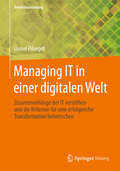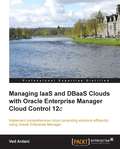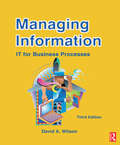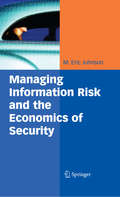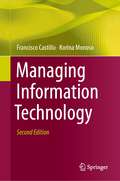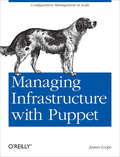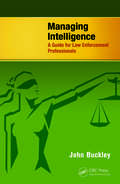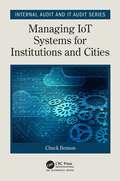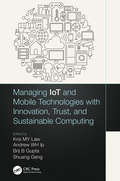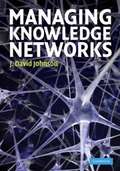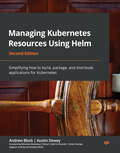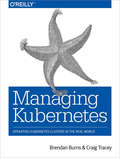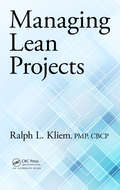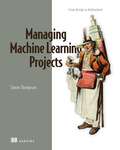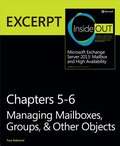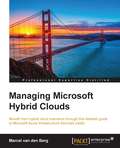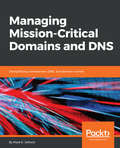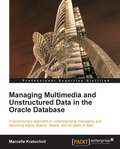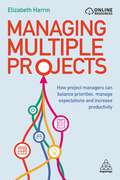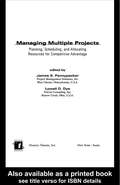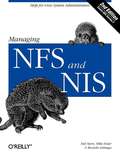- Table View
- List View
Managing IT in einer digitalen Welt: Zusammenhänge der IT verstehen und die Kriterien für eine erfolgreiche Transformation beherrschen
by Lionel PilorgetDie IT ist für viele Unternehmen unersetzbar geworden. Die Digitalisierung, die in der Zwischenzeit sich verbreitet hat und die Gesellschaft immer weiter prägt, bleibt eine Priorität für viele Unternehmen. Nun hat die Komplexität zugenommen. Es sei die Wahl eines nachhaltigen Partners für eine Cloud Transformation, die Garantie, dass neue digitale Lösungen absolut sicher sind, oder das Angebot eines modernen Arbeitsplatzes, wo Home Office selbstverständlich ist. Entscheidend und gleichzeitig herausfordernd ist die Tatsache, dass alle Ebenen einer IT Organisation gut zusammenarbeiten müssen, damit das Unternehmen sich erfolgreich weiterentwickeln kann. Es handelt sich um die strategische Ebene mit den entsprechenden strategischen Entscheidungen, in erster Linie "make-or-buy" Entscheide. Weiterhin muss die taktische Ebene mit der Durchführung von Projekten und Releases und gleichzeitig das Angebot von hochwertigen IT Services sehr gut funktionieren. Die operative Ebene stellt das Fundament dar, wo die Abwicklung aller Tätigkeiten des Unternehmens sichergestellt werden muss. Verfügbarkeit und Performanz sind Key. Das ganze "Haus der IT" muss in dem Kontext des Unternehmens funktionieren. Die Kultur der Organisation und die Strukturen müssen natürlich berücksichtigt werden. Um eine optimale Transformation der IT ermöglichen zu können, ist es wichtig, ein gutes Verständnis einer IT Organisation zu besitzen und die Zusammenhänge zu verstehen.
Managing IaaS and DBaaS Clouds with Oracle Enterprise Manager Cloud Control 12c
by Ved AntaniThis book is a step-by-step tutorial filled with practical examples which will show readers how to configure and manage IaaS and DBaaS with Oracle Enterprise Manager.If you are a cloud administrator or a user of self-service provisioning systems offered by Enterprise Manager, this book is ideal for you. It will also help administrators who want to understand the chargeback mechanism offered by Enterprise Manager.An understanding of the basic building blocks of cloud computing such as networking, virtualization, storage, and so on, is needed by those of you interested in this book
Managing Information
by David A Wilson'Managing Information' describes how successful organizations make best use of information and knowledge - the key resources in business. It explains why information technology is essential for the management of business processes, and should be central to any business strategy. This updated edition provides a compelling rationale for organizations to use appropriate systems, and for individuals to acquire the skills to manage and use the systems. It describes how computer systems continue to evolve to meet business needs, and provides examples and exercises to help readers develop their skills. There is a new emphasis on the Internet - how to use it to keep up to date with the latest business issues, and how teams can communicate and collaborate with intranets.All of the most common sub-systems are described and explained, including Enterprise Resource Planning (ERP), Business-to-Business (B2B), Business-to-Consumer (B2C), Supply Chain Management (SCM), Customer Relationship Management (CRM) and Enterprise Application Integration (EAI). The latest developments are described, including services available through the Internet from Application Service Providers (ASP), collaborative commerce and Business Process Management (BPM).There are introductory and more advanced computer exercises to consolidate learning and demonstrate how to acquire, store, organize and present information, using Word, Excel, PowerPoint and Explorer.
Managing Information Risk and the Economics of Security
by M. Eric JohnsonThe lifeblood of the global economy, information has become a source of growing risk as more firms maintain information online. With risks now fueled by sophisticated, organized, malicious groups, information security requires not only technology, but a clear understanding of potential risks, decision-making behaviors, and metrics for evaluating business and policy options. Managing Information Risk and the Economics of Security, an edited volume contributed by well-established researchers in the field worldwide, presents the latest research on economics driving both the risks and the solutions. Covering the implications of policy within firms and across countries, this volume provides managers and policy makers with new thinking on how to manage risk. Managing Information Risk and the Economics of Security is designed for managers, policy makers, and researchers focusing on economics of information security, as well as for advanced-level students in computer science, business management and economics.
Managing Information Risk: A Director's Guide
by Stewart MitchellThis pocket guide addresses the scope of risks involved in a modern IT system, and outlines strategies for working through the process of putting risk management at the heart of your corporate culture. This pocket guide should provide decision makers with a solid overview of the factors they need to consider and a framework for implementing a regime that suits their needs. It provides a checklist of steps that companies need to take to safeguard against various threats, highlights potential vulnerabilities and lists methodologies for mitigating against the risks. This pocket guide draws on previous works by senior security advisory bodies - in particular the US National Institute of Standards and Technology, which has produced numerous landmark 'Special Publications' on the subject, and various UK government guidelines drawn up in the wake of high- profile data breaches. UK governmental and industry white papers were also consulted during research, including interviews with security analysts and board-level risk management practitioners.
Managing Information Technology
by Francisco Castillo Korina MonosoThere are two different, interdependent components of IT that are important to a CIO: strategy, which is long-term; and tactical and operational concerns, which are short-term. Based on this distinction and its repercussions, this book clearly separates strategy from day-to-day operations and projects from operations – the two most important functions of a CIO.It starts by discussing the ideal organization of an IT department and the rationale behind it, and then goes on to debate the most pressing need – managing operations. It also explains some best industry standards and their practical implementation, and discusses project management, again highlighting the differences between the methodologies used in projects and those used in operations. A special chapter is devoted to the cutover of projects into operations, a critical aspect seldom discussed in detail. Other chapters touch on the management of IT portfolios, project governance, as well as agile project methodology,how it differs from the waterfall methodology, and when it is convenient to apply each. In this second edition, besides a number of corrections and updates throughout the text, chapter 8 on “Agile Project Management” replaces the former chapter 8 completely, and chapter 10 on “IT Security” has been newly introduced as this topic has become more and more important for both management and operations during the last six years.Taking the fundamental principles of IT service management and best practices in project management, the book offers a single, seamless reference for IT managers and professionals. It is highly practical, explaining how to apply these principles based on the author’s extensive experience in industry.
Managing Infrastructure with Puppet: Configuration Management at Scale
by James LoopeGet started with Puppet, and learn how this popular configuration management framework helps you automate your servers. This concise introduction shows you how to use Puppet’s tools and templates to organize and execute configuration plans on Linux, Unix, and Windows servers. Through code samples and real-world examples, you’ll learn how to manage pools of servers and virtual instances, and how to administer access control. If you’re new to Puppet, but familiar with systems administration and Ruby language basics, this book is the ideal way to start using this open source framework.Learn Puppet fundamentals, including its manifest syntax and built-in functionsStore configurations in a central location with PuppetMaster, and define which configurations apply to which nodesBuild a framework to create user accounts in place of LDAP or Kerberos KDCApply techniques to execute and manage server configurations with MCollectiveUse Puppet as an auditing tool to ensure that configurations are correctGather information on the nodes you manage with the Facter library
Managing Innovation in Japan
by Chihiro WatanabeWhy do some country's hi-tech firms innovate better than others? Why did hi-tech firms from the United States outperform such Japanese companies in the 1990s? Through a wealth of empirical evidence, the book compares the development trajectory of manufacturing technology and information technology both between Japanese companies and between companies based in the US, Europe, Australia, India and China. This book shows that institutional systems such as culture, tradition, consumers and local business practices play key roles in how companies develop technology. These factors also influence the very characteristics of the products that the hi-tech firms produce. With a number of case studies the author demonstrates how the most successful and innovative companies recognize these roles and incorporate them into their practices.
Managing Intelligence: A Guide for Law Enforcement Professionals
by John BuckleyManaging Intelligence: A Guide for Law Enforcement Professionals is designed to assist practitioners and agencies build an efficient system to gather and manage intelligence effectively and lawfully in line with the principles of intelligence-led policing. Research for this book draws from discussions with hundreds of officers in different agencies, roles, and ranks from the UK, United States, Australia, New Zealand, and Canada. Highlighting common misunderstandings in law enforcement about intelligence, the book discusses the origins of these misunderstandings and puts intelligence in context with other policing models.
Managing IoT Systems for Institutions and Cities (Internal Audit and IT Audit)
by Chuck BensonThis book defines what IoT Systems manageability looks like and what the associated resources and costs are of that manageability. It identifies IoT Systems performance expectations and addresses the difficult challenges of determining actual costs of IoT Systems implementation, operation, and management across multiple institutional organizations. It details the unique challenges that cities and institutions have in implementing and operating IoT Systems.
Managing IoT and Mobile Technologies with Innovation, Trust, and Sustainable Computing
by Edited by Kris MY Law, Andrew WH Ip, Brij B Gupta and Shuang GengFocused on the latest mobile technologies, this book addresses specific features (such as IoT) and their adoptions that aim to enable excellence in business in Industry 4.0. Furthermore, this book explores how the adoption of these technologies is related to rising concerns about privacy and trusted communication issues that concern management and leaders of business organizations. Managing IoT and Mobile Technologies with Innovation, Trust, and Sustainable Computing not only targets IT experts and drills down on the technical issues but also provides readers from various groups with a well-linked concept about how the latest trends of mobile technologies are closely related to daily living and the workplace at managerial and even individual levels.
Managing Knowledge Networks
by J. David JohnsonThe information context of the modern organization is rapidly evolving in the face of intense global competition. Information technologies, including databases, new telecommunications systems, and software for synthesizing information, make a vast array of information available to an ever expanding number of organizational members. Management's exclusive control over knowledge is steadily declining, in part because of the downsizing of organizations and the decline of the number of layers in an organizational hierarchy. These trends, as well as issues surrounding the Web 2.0 and social networking, mean that it is increasingly important that we understand how informal knowledge networks impact the generation, capturing, storing, dissemination, and application of knowledge. This innovative book provides a thorough analysis of knowledge networks, focusing on how relationships contribute to the creation of knowledge, its distribution within organizations, how it is diffused and transferred, and how people find it and share it collaboratively.
Managing Kubernetes Resources Using Helm: Simplifying how to build, package, and distribute applications for Kubernetes, 2nd Edition
by Andrew Block Austin Dewey Rimantas Mocevicius “rimusz”Reduce the complexity of managing applications on Kubernetes and develop an enterprise pattern for application deliveryKey FeaturesLearn best practices from the core maintainer of Helm for application delivery and life cycle managementManage applications deployed in Kubernetes effectively using HelmGo beyond the basics when using Helm with key security considerations and management optionsBook DescriptionContainerization is one of the best ways to implement DevOps, and learning how to execute it effectively is an essential part of a developer's skillset. Kubernetes is the current industry standard for container orchestration. This book will help you discover the efficiency of managing applications running on Kubernetes with Helm. Starting with a brief introduction to Helm and its impact on users working with containers and Kubernetes, you'll delve into the primitives of Helm charts and their architecture and use cases. From there, you'll understand how to write Helm charts in order to automate application deployment on Kubernetes and work your way toward more advanced strategies. These enterprise-ready patterns are focused on concepts beyond the basics so that you can use Helm optimally, looking at topics related to automation, application development, delivery, lifecycle management, and security. By the end of this book, you'll have learned how to leverage Helm to build, deploy, and manage applications on Kubernetes.What you will learnUnderstand how to deploy applications on Kubernetes with easePackage dynamic applications for deployment on KubernetesIntegrate Helm into an existing software release processDevelop an enterprise automation strategy on Kubernetes using HelmUse Helm within a Helm Kubernetes operatorLeverage Helm in a secure and stable manner that fits the enterpriseDiscover the ins and outs of automation with HelmWho this book is forThis book is for Kubernetes developers or administrators who are interested in learning Helm to provide automation for app development on Kubernetes. Although no prior knowledge of Helm is required, basic knowledge of Kubernetes application development will be useful.
Managing Kubernetes: Operating Kubernetes Clusters in the Real World
by Brendan Burns Craig TraceyWhile Kubernetes has greatly simplified the task of deploying containerized applications, managing this orchestration framework on a daily basis can still be a complex undertaking. With this practical book, site reliability and DevOps engineers will learn how to build, operate, manage, and upgrade a Kubernetes cluster—whether it resides on cloud infrastructure or on-premises.Brendan Burns, cofounder of Kubernetes, and Craig Tracey, staff field engineer at Heptio, dissect how Kubernetes works internally and demonstrate ways to maintain, adjust, and improve the cluster to suit your particular use case. You’ll learn how to make architectural choices for designing a cluster, managing access control, monitoring and alerting, and upgrading Kubernetes. Dive in and discover how to take full advantage of this orchestration framework’s capabilities.Learn how your cluster operates, how developers use it to deploy applications, and how Kubernetes can facilitate a developer’s jobAdjust, secure, and tune your cluster by understanding Kubernetes APIs and configuration optionsDetect cluster-level problems early and learn the steps necessary to respond and recover quicklyDetermine how and when to add libraries, tools, and platforms that build on, extend, or otherwise improve a Kubernetes cluster
Managing Lean Projects
by Ralph L. KliemLean is a set of disciplines that can result in tremendous savings and profitability for companies. It can significantly reduce cycle times and increase customer satisfaction. Lean, however, must be applied efficiently and effectively to achieve optimum results. This book discusses project management concepts, tools, and techniques as they apply to
Managing Machine Learning Projects: From design to deployment
by Simon ThompsonGuide machine learning projects from design to production with the techniques in this unique project management guide. No ML skills required!In Managing Machine Learning Projects you&’ll learn essential machine learning project management techniques, including: Understanding an ML project&’s requirements Setting up the infrastructure for the project and resourcing a team Working with clients and other stakeholders Dealing with data resources and bringing them into the project for use Handling the lifecycle of models in the project Managing the application of ML algorithms Evaluating the performance of algorithms and models Making decisions about which models to adopt for delivery Taking models through development and testing Integrating models with production systems to create effective applications Steps and behaviors for managing the ethical implications of ML technology Managing Machine Learning Projects is an end-to-end guide for delivering machine learning applications on time and under budget. It lays out tools, approaches, and processes designed to handle the unique challenges of machine learning project management. You&’ll follow an in-depth case study through a series of sprints and see how to put each technique into practice. The book&’s strong consideration to data privacy, and community impact ensure your projects are ethical, compliant with global legislation, and avoid being exposed to failure from bias and other issues. About the Technology Ferrying machine learning projects to production often feels like navigating uncharted waters. From accounting for large data resources to tracking and evaluating multiple models, machine learning technology has radically different requirements than traditional software. Never fear! This book lays out the unique practices you&’ll need to ensure your projects succeed. About the Book Managing Machine Learning Projects is an amazing source of battle-tested techniques for effective delivery of real-life machine learning solutions. The book is laid out across a series of sprints that take you from a project proposal all the way to deployment into production. You&’ll learn how to plan essential infrastructure, coordinate experimentation, protect sensitive data, and reliably measure model performance. Many ML projects fail to create real value—read this book to make sure your project is a success. What's Inside Set up infrastructure and resource a team Bring data resources into a project Accurately estimate time and effort Evaluate which models to adopt for delivery Integrate models into effective applications About the Reader For anyone interested in better management of machine learning projects. No technical skills required. About the Author Simon Thompson has spent 25 years developing AI systems to create applications for use in telecoms, customer service, manufacturing and capital markets. He led the AI research program at BT Labs in the UK, and is now the Head of Data Science at GFT Technologies. Table of Contents 1 Introduction: Delivering machine learning projects is hard; let&’s do it better 2 Pre-project: From opportunity to requirements 3 Pre-project: From requirements to proposal 4 Getting started 5 Diving into the problem 6 EDA, ethics, and baseline evaluations 7 Making useful models with ML 8 Testing and selection 9 Sprint 3: system building and production 10 Post project (sprint O)
Managing Mailboxes, Groups, & Other Objects: EXCERPT from Microsoft Exchange Server 2013 Inside Out
by Tony RedmondThis content is a direct excerpt of Chapters 5 and 6 from the book Microsoft Exchange Server 2013 Inside Out: Mailbox & High Availability. This concise ebook is offered independently of the larger book for those seeking specific, focused information on managing mailboxes, groups, and other objects in Exchange Server 2013. Directly excerpts Chapters 5 and 6 from the book Microsoft Exchange Server 2013 Inside Out: Mailbox & High Availability Offered as concise, standalone content for Exchange professionals looking for narrowly focused reference or specific problem-solving information on managing mailboxes, groups, and other objects Written by award-winning author Tony Redmond, MVP for Exchange Server
Managing Microsoft Hybrid Clouds
by Marcel Van BergIf you're an IT professional, manager, consultant, or architect who wants to learn about hybrid cloud computing using Azure, then this is the book for you.
Managing Microsoft Teams: Configure and manage Microsoft Teams workloads and achieve Microsoft 365 certification with ease
by Nate Chamberlain Peter RisingDiscover how to plan a Microsoft Teams deployment within a business environment and manage Teams administrative functions on a day-to-day basisKey FeaturesPlan and design your Microsoft Teams deploymentPrepare, deploy, and manage policies for Microsoft Teams and for apps within TeamsPass the MS-700 exam and achieve certification with the help of self-assessment questions and a mock examBook DescriptionDo you want to build and test your proficiency in the deployment, management, and monitoring of Microsoft Teams features within the Microsoft 365 platform? Managing Microsoft Teams: MS-700 Exam Guide will help you to effectively plan and implement Microsoft Teams using the Microsoft 365 Teams admin center and Windows PowerShell. You'll also discover best practices for rolling out and managing MS services for Teams users within your Microsoft 365 tenant. The chapters are divided into three easy-to-follow parts: planning and design, feature policies and administration, and team management, while aligning with the official MS-700 exam objectives to help you prepare effectively for the exam. The book starts by taking you through planning and design, where you'll learn how to plan migrations, make assessments for network readiness, and plan and implement governance tasks such as configuring guest access and monitoring usage. Later, you'll understand feature administration, focusing on collaboration, meetings, live events, phone numbers, and the phone system, along with applicable policy configurations. Finally, the book shows you how to manage Teams and membership settings and create app policies. By the end of this book, you'll have learned everything you need to pass the MS-700 certification exam and have a handy reference guide for MS Teams.What you will learnExplore Security & Compliance configuration options for Teams featuresManage meetings, calls, and chat features within Microsoft TeamsFind out how to manage phone numbers, systems, and settings in TeamsManage individual team settings, membership, and guest accessCreate policies for Microsoft Teams apps and featuresDeploy access reviews and dynamic team membershipWho this book is forThis Microsoft Teams book is for IT professionals who want to achieve Microsoft 365 Certified: Teams Administrator Associate certification. Familiarity with the principles of establishing and administering the core features and services within a Microsoft 365 tenant and a basic understanding of Microsoft Teams features are required before getting started with the book. Prior knowledge of other Microsoft 365 workloads such as Security & Compliance will also be beneficial.
Managing Mission - Critical Domains and DNS: Demystifying nameservers, DNS, and domain names
by Mark JeftovicThis book will give you an all encompassing view of the domain name ecosystem combined with a comprehensive set of operations strategies.Key FeaturesManage infrastructure, risk, and management of DNS name servers. Get hands-on with factors like types of name servers, DNS queries and and so on. Practical guide for system administrators to manage mission-critical serversBased on real-world experience - Written by an industry veteran who has made every possible mistake within this field.Book DescriptionManaging your organization's naming architecture and mitigating risks within complex naming environments is very important. This book will go beyond looking at “how to run a name server” or “how to DNSSEC sign a domain”, Managing Mission Critical Domains & DNS looks across the entire spectrum of naming; from external factors that exert influence on your domains to all the internal factors to consider when operating your DNS. The readers are taken on a comprehensive guided tour through the world of naming: from understanding the role of registrars and how they interact with registries, to what exactly is it that ICANN does anyway? Once the prerequisite knowledge of the domain name ecosystem is acquired, the readers are taken through all aspects of DNS operations. Whether your organization operates its own nameservers or utilizes an outsourced vendor, or both, we examine the complex web of interlocking factors that must be taken into account but are too frequently overlooked. By the end of this book, our readers will have an end to end to understanding of all the aspects covered in DNS name servers.What you will learnAnatomy of a domain - how a domain is the sum of both its DNS zone and its registration data, and why that matters.The domain name ecosystem - the role of registries, registrars and oversight bodies and their effect on your names.How DNS queries work - queries and responses are examined including debugging techniques to zero in on problems.Nameserver considerations - alternative nameserver daemons, numbering considerations, and deployment architectures.DNS use cases - the right way for basic operations such as domain transfers, large scale migrations, GeoDNS, Anycast DNS.Securing your domains - All aspects of security from registrar vendor selection, to DNSSEC and DDOS mitigation strategies.Who this book is forIdeal for sysadmins, webmasters, IT consultants, and developers-anyone responsible for maintaining your organization's core DNS
Managing Multimedia and Unstructured Data in the Oracle Database
by Marcelle KratochvilThis book is written in simple, easy to understand format with lots of screenshots and step-by-step explanations. If you are an Oracle database administrator, Museum curator, IT manager, Developer, Photographer, Intelligence team member, Warehouse or Software Architect then this book is for you. It covers the basics and then moves to advanced concepts. This will challenge and increase your knowledge enabling all those who read it to gain a greater understanding of multimedia and how all unstructured data is managed.
Managing Multiple Projects: How Project Managers Can Balance Priorities, Manage Expectations and Increase Productivity
by Elizabeth HarrinProject management is changing. Rather than focusing solely on one large project, the majority of project managers are now expected to juggle multiple projects, which brings a different set of challenges. Between a greater number of project sponsors, resource conflicts and constant pressure from deadlines, it can be difficult to avoid burnout. Managing Multiple Projects blends formal project management techniques with time management and productivity tools in a step-by-step approach to consolidating your workload. From combining schedules to prioritising work and engaging stakeholders, this book clearly explains how to adapt your behaviour and techniques to successfully work on several projects at once.This practical guide provides answers to commonly asked questions (such as how to reduce the number of meetings and how to manage a To Do list) and includes case studies from real project managers. Checklists for common tasks and adaptable templates of trackers and reports are combined with easily actioned exercises to improve processes. Managing Multiple Projects gives practitioners the tools they need to improve the chances of project success and maintain a work-life balance. Online resources include downloadable templates of productivity checklists and status reports.
Managing Multiple Projects: Planning, Scheduling, and Allocating Resources for Competitive Advantage
by James S. Pennypacker Lowell D. DyeProject leaders, managers, and team members, as well as cost engineers, analysts, and students in project management and planning, can glean ideas and methods for managing multiple projects from this reference. It details time-efficient and cost-effective strategies for evaluating, selecting, prioritizing, planning, and managing multiple projects. The editors present proven methods and practical applications for the development of successful project portfolios and prosperous multi-project environments. Edited by pioneers in the field, with contributions from a panel of experts, the book provides useful models and scheduling frameworks for increased quality and productivity.
Managing NFS and NIS, 2nd Edition
by Mike Eisler Ricardo Labiaga Hal SternThis long-awaited new edition of a classic, now updated for NFS Version 3 and based on Solaris 8, shows how to set up and manage a network filesystem installation. Managing NFS and NIS is the only practical book devoted entirely to NFS and the distributed database NIS; it's a "must-have" for anyone interested in Unix networking.
Managing NFS and NIS, 2nd Edition
by Mike Eisler Ricardo Labiaga Hal SternThis long-awaited new edition of a classic, now updated for NFS Version 3 and based on Solaris 8, shows how to set up and manage a network filesystem installation. Managing NFS and NIS is the only practical book devoted entirely to NFS and the distributed database NIS; it's a "must-have" for anyone interested in Unix networking.
